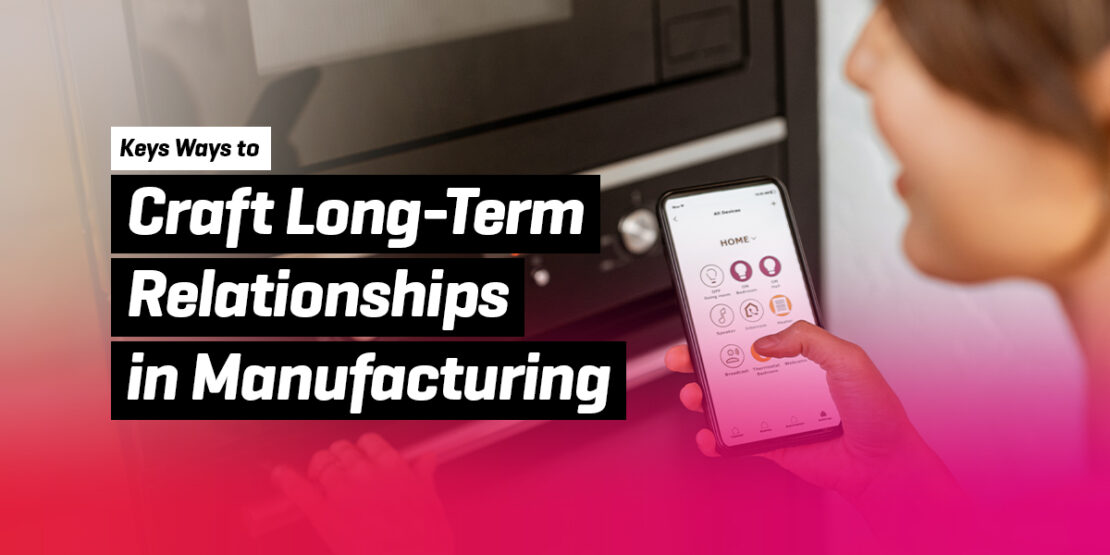The pandemic has presented manufacturers with a host of challenges to overcome, from supply chain issues and relationships with intermediaries and partners, to changing customer trends and expectations. However, without understanding the customer base and how to develop lasting customer relationships in the post-pandemic marketplace, making the right decisions regarding investment and ranking issues in terms of strategic priority could prove impossible.
Regardless of industry, business sector or position within the wider marketplace, organisations that succeed are those that can build and maintain the strongest customer relationships.
The better the bond a consumer has with a brand, the less likely that person is to sever ties and take their business elsewhere, even after a disappointing experience. Likewise, customers with a strong affinity for an organisation have a greater lifetime value and over time, as their loyalty towards the brand increases, so will the possibility that they will become vocal advocates.
As such, it’s impossible to overstate the importance of building and maintaining strong customer relationships. However, it’s also impossible to attract and retain people to a brand unless that organisation understands that a strong customer relationship is the result of delivering a consistently positive customer experience. And, what constitutes as a positive, differentiating CX is dictated by customer need and expectation.
It’s for this reason that the first step towards building strong customer relationships is understanding exactly who the customers is and their motivations behind choosing one brand over another.
Step 1: Define Who Your Customers Are
Developing a clear picture of who your customers are and then segmenting and personifying them appropriately requires data collection — from as many sources as possible. Within the organisation it means analysing customer conversations with live agents within the contact centre, through the use of speech and text analytics, and combining it with customer survey findings, CRM data and customer-facing employee feedback.
Externally, the use of social monitoring and listening will provide a bigger, contextual picture of how the organisation’s brand is perceived and how it sits within the wider marketplace. At this moment in time, following such a seismic change in consumer behaviour and consequent expectations, conducting this type of outward-facing data gathering exercise has never been more valuable.
Once these insights are pooled, creating customer personas becomes easy, as does identifying particular types of customer need and motivations relating to the brand. The final step of the customer definition process is conducting a Voice of the Customer (VOC) program, the results of which should validate initial conclusions.
Step 2: Map Customer Journeys
Mapping individual types of customer journey relating to each identified persona and underlying motivation will reveal if each existing touch-point, at each point of the sales funnel, is delivering on expectation. This exercise should highlight potential inconsistencies — for instance between channels such as online chat and the phone — as well as opportunities for optimisation.
Step 3: Remove Customer Effort
One of the most effective ways of optimising CX and eliminating unnecessary customer effort, particularly for organisations that sell manufactured goods, is through a greater focus on self-service and automation. FAQs, tutorials and how-to videos to turn website visits into a real interactive, time-saving and value-added experience. These tools and features can be further expanded upon with chatbots for handling the most common contact drivers and for prequalifying customers for an interaction with an agent — whether through online chat or other live channels — if the query or issue is beyond the scope of an automated response.
Step 4: Enhance Agent Ability
With a well-conceived and well-maintained self-service option in place, the majority of live contacts coming into the organisation will be of a complex nature. These types of interactions are often “moments of truth.” In other words, how these conversations conclude could mean the difference between increased loyalty and advocacy or an increased potential for attrition.
Therefore, ensure all agent-facing knowledge bases are constantly updated and continued coaching and agent training is a priority. Through the application of speech and text analytics, improvements to agent training can be made in real time to the point where managers and coaches can proactively guide the agent through a conversation and towards a positive emotional resolution.
Step 5: Measure Performance
The final step is to continuously measure performance against customer expectations. The application of metrics such as NPS and CSAT will highlight how specific touchpoints and channels are performing. These metrics should be supported with the use of clickstream analytics for understanding how digital assets are performing and, of course, the continued use of VOC programs and customer feedback surveys alongside speech and text analytics.
Without a consistent and consistently positive customer experience, it is impossible to build long-term customer relationships and, without long-term customer relationships underpinning an organisation, it is impossible to maintain long-term business success.
